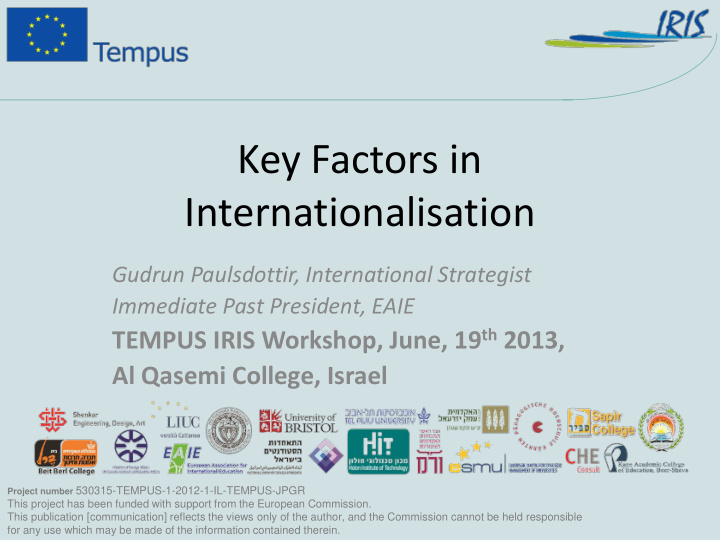



Key Factors in Internationalisation Gudrun Paulsdottir, International Strategist Immediate Past President, EAIE TEMPUS IRIS Workshop, June, 19 th 2013, Al Qasemi College, Israel Project number 530315-TEMPUS-1-2012-1-IL-TEMPUS-JPGR This project has been funded with support from the European Commission. This publication [communication] reflects the views only of the author, and the Commission cannot be held responsible for any use which may be made of the information contained therein.
The Global Environment • How did we get where we are? • Organic growth • Very different objectives • Very different stakeholders • Trade • Competition • Collaboration
Composition of the Global Environment • Over 17 000 institutions of HE • Very diverse • Different political contexts • Different societal requirements • Different views on what it takes • Different reasons for engaging in international education • All the others
Global Facts • 3 700 000 global students today • 2-300 million are looking for education • Every country is looking for talent • Work and study environment • Internationally jointly written research papers get more citations • Geographical positioning
• Data source: Anagrafe Nazionale studenti, MIUR, 2012/13 Chart C4.4. Student mobility in tertiary education (2010) Percentage of international and foreign students in tertiary enrolments % 41.40625 Foreign students2 International students 25 20 15 10 OECD average 5 0 Luxembourg Australia United Kingdom Austria Switzerland New Zealand Belgium Denmark Ireland Sweden Canada¹ Iceland Netherlands Finland Hungary Slovak Republic Japan United States Spain Portugal Estonia Slovenia Norway Poland Chile France Czech Republic South Africa1 Greece Italy Saudi Arabia Korea Russian Federation Turkey China Brazil Indonesia 1 . Year of reference 2009 . 2. Foreign students are defined on the basis of their country of citizenship, these data are not comparable with data on international students and are therefore presented separately in the table. Countries are ranked in descending order of the percentage of international students in tertiary education. Source: OECD. Table C4.1. See Annex 3 for notes ( www.oecd.org/edu/eag2012). 5
External Pressure on HE • Changes in the global environment • From organisations – United Nations – OECD – European Union • From Governments • From other stakeholders
The European Experience • EU financial support • Satelite activity • Enthousiasts • Huge growth • Impact on university activities • Strategies • Integration
Integrated strategic approach • Internationalisation embedded everywhere – Spreading in Europe and the US – Already in place in Asia – Getting there in Latin America • Very important in order to maximize effects • Gives better control over the activities – In line with vision and strategy • Leads to better resource management
Vision and Strategy • Long term – short term • Your identity – Regional • What are you trying to achieve – Higher level of education in the region – Regional development – Employable work force • How can internationalisation contribute
Identify expected outcomes • Institutional development • Enhanced competence for all • More international research cooperation • More intercultural competence • Multidisciplinarity • Mobility • Increased quality • Internationalisation at Home
Impact on the organisation • Some factors have more impact than others • Impact can show where least expected • Impacts can be monitored • Be prepared and pro-active • Some key factors are – Language/quality/strategic partnerships
Language • English is the communication tool in international higher education • Impact on local languages and culture • Feedback from students • A Nordic experience • Asset for researchers and staff • Asset for students
Countries offering English taught programmes 13
Discussion • Discuss around the tables the pro’s and con’s with teaching in another language. • Some of you already do – would you add yet another one?
Definition • Define what internationalisation means to your institution • Put all your expeted outcomes in line with that definition • Revisit and redefine if/when necessary
Quality • International – global – comparative • Exposure of all academic activities • National requirements • International competition • Institutional interests • Students • Employers view on HE • Value of internationlisation
Strategic Partnerships • Sustainability in relationships – Importance of individuals • On all levels – Faculty/students/administrative • In all areas – Education/reseach/projects/society • Agreements – Strategic/basic
Recommend
More recommend